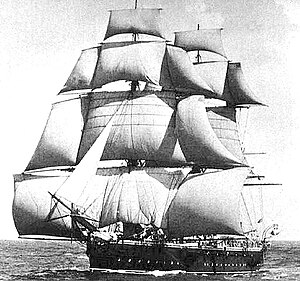 HMS Calypso
| |
| Class overview | |
|---|---|
| Name | Calypso class |
| Operators | |
| Preceded by | Comus class |
| Succeeded by | None |
| Built | 1883–1884 |
| In commission | 1885–1907 |
| Completed | 2 |
| Scrapped | 2 |
| General characteristics [1] | |
| Type | Screw corvette |
| Displacement | 2,770 tons |
| Length | 235 ft 0 in (71.6 m) pp |
| Beam | 44 ft 6 in (13.6 m) |
| Draught | 19 ft 11 in (6.1 m) |
| Installed power | 4,023 ihp (3,000 kW) |
| Propulsion |
|
| Sail plan | Barque rig |
| Speed | 13.75 kn (25.5 km/h) powered; 14.75 kn (27.3 km/h) forced draught |
| Complement | 293 (later 317) |
| Armament |
|
| Armour | Deck: 1.5 in (38 mm) over engines |
The Calypso class comprised two steam corvettes (later classified as third-class cruisers) of the Royal Navy. Built for distant cruising in the heyday of the British Empire, they served with the fleet until the early twentieth century, when they became training ships. Remnants of both survive, after a fashion; HMS Calliope in the name of the naval reserve unit the ship once served, and HMS Calypso both in the name of a civilian charity and the more corporeal form of the hull, now awash in a cove off Newfoundland.
The class exemplifies the transitional nature of the late Victorian navy. In design, materials, armament, and propulsion the Calypsos show evidence of their wooden sailing antecedents, blended with characteristics of the all-metal mastless steam warships which followed. Their appearance and layout was similar to the "pure" sailing corvettes, with boiler rooms, machinery spaces, ventilators, and a flue added. Of iron and steel construction, they had coppering over timber below the waterline, as did older wooden vessels. Their armament was not in turrets or barbettes, but arranged in a central broadside battery, with the four largest guns on sponsons to give larger arcs of fire. And they had both a powerful steam engine and an extensive rig of sail. They formed the last class of sailing corvettes in the Royal Navy.[1][Note 1]
Cite error: There are <ref group=Note> tags on this page, but the references will not show without a {{reflist|group=Note}} template (see the help page).